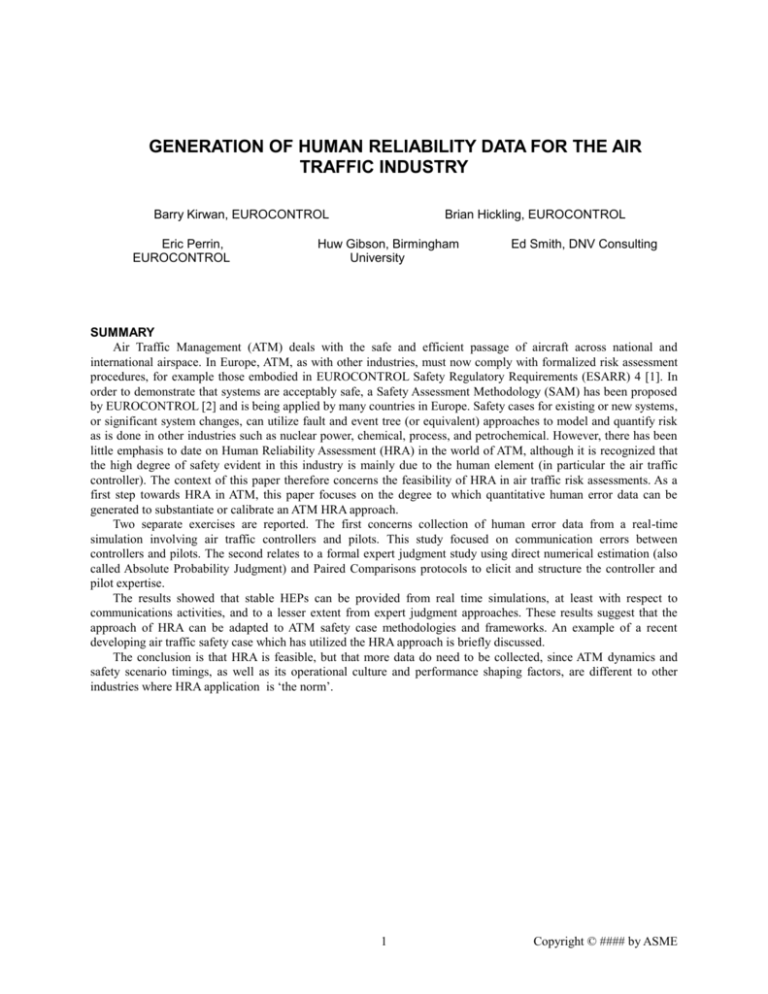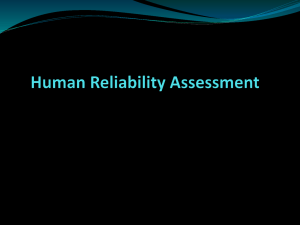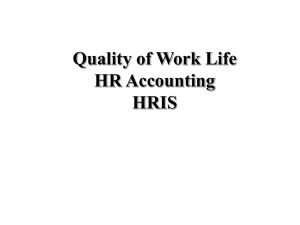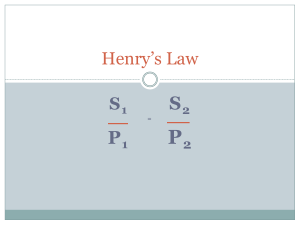Generation of human reliability data for the air traffic
advertisement

GENERATION OF HUMAN RELIABILITY DATA FOR THE AIR
TRAFFIC INDUSTRY
Barry Kirwan, EUROCONTROL
Eric Perrin,
EUROCONTROL
Brian Hickling, EUROCONTROL
Huw Gibson, Birmingham
University
Ed Smith, DNV Consulting
SUMMARY
Air Traffic Management (ATM) deals with the safe and efficient passage of aircraft across national and
international airspace. In Europe, ATM, as with other industries, must now comply with formalized risk assessment
procedures, for example those embodied in EUROCONTROL Safety Regulatory Requirements (ESARR) 4 [1]. In
order to demonstrate that systems are acceptably safe, a Safety Assessment Methodology (SAM) has been proposed
by EUROCONTROL [2] and is being applied by many countries in Europe. Safety cases for existing or new systems,
or significant system changes, can utilize fault and event tree (or equivalent) approaches to model and quantify risk
as is done in other industries such as nuclear power, chemical, process, and petrochemical. However, there has been
little emphasis to date on Human Reliability Assessment (HRA) in the world of ATM, although it is recognized that
the high degree of safety evident in this industry is mainly due to the human element (in particular the air traffic
controller). The context of this paper therefore concerns the feasibility of HRA in air traffic risk assessments. As a
first step towards HRA in ATM, this paper focuses on the degree to which quantitative human error data can be
generated to substantiate or calibrate an ATM HRA approach.
Two separate exercises are reported. The first concerns collection of human error data from a real-time
simulation involving air traffic controllers and pilots. This study focused on communication errors between
controllers and pilots. The second relates to a formal expert judgment study using direct numerical estimation (also
called Absolute Probability Judgment) and Paired Comparisons protocols to elicit and structure the controller and
pilot expertise.
The results showed that stable HEPs can be provided from real time simulations, at least with respect to
communications activities, and to a lesser extent from expert judgment approaches. These results suggest that the
approach of HRA can be adapted to ATM safety case methodologies and frameworks. An example of a recent
developing air traffic safety case which has utilized the HRA approach is briefly discussed.
The conclusion is that HRA is feasible, but that more data do need to be collected, since ATM dynamics and
safety scenario timings, as well as its operational culture and performance shaping factors, are different to other
industries where HRA application is ‘the norm’.
1
Copyright © #### by ASME
INTRODUCTION
Human Reliability Assessment (HRA) has been around for some time, notably since the Three Mile Island
nuclear power plant accident in 1979, when the Technique for Human Error Rate Prediction (THERP) [3] became
the predominant technique in use. Since that time, the usage of HRA has spread to other process-control-related
industries (petrochemical; chemical and process). Recently it has also spread to the transportation sector, notably the
rail industry, and the medical and air traffic management domains are increasingly focusing on the management and
assessment of human error [4].
HRA has several main attributes [3, 5], principally determining what can go wrong (human error identification),
determining the risk significance of errors (or correct performance: the kernel of this function being human error
quantification), and identifying how to mitigate human-related risks or assure safe human performance (error
reduction). HRA can be seen as an engineering function (belonging principally to the sub-discipline of Reliability
Engineering) or as a Human Factors function. In truth it belongs to both domains, and normally people carrying out
HRA are ‘hybrid’ practitioners with a mixture of reliability engineering and Human Factors/psychology expertise.
HRA is however usually most clearly associated with its second main function, namely the quantification of human
error likelihood (i.e. how frequently will a particular error actually occur?). This likelihood is usually expressed as a
probability, called a Human Error Probability (HEP), which is effectively the probability of an error per demand. In
theory, and in practice, HRA rests upon a fundamental premise that HEPs can be quantified, i.e. that they exist as
stable quantitative values.
The quantitative expression for an HEP is straightforward and is shown below, based on the idea that a HEP can
be measured by observation1:
HEP = number of errors observed / number of opportunities for error
Whenever HRA is being applied to a new industry, it must map onto the risk or safety management framework
and indeed the organizational ‘culture’ of that industry. Where such an industry already has a quantitative approach
to risk (e.g. nuclear power), HRA may ‘find its niche’ quickly. Conversely, where risk is managed more qualitatively,
it may encounter resistance and incredulity from those who need to be convinced in order for it to be utilized
effectively. Thus, HRA in the medical domain at the moment is mainly being used qualitatively (for error
identification and reduction purposes). But in ATM, the whole industry in Europe has been undergoing a paradigm
shift in safety assessment, moving from a more ‘implicit’ and qualitative approach to a formalized methodological
framework with quantitatively stated target levels of safety that safety cases need to reach. This leads to formal use of
techniques such as fault and event trees, and in some cases dynamic risk assessment approaches. The former
approaches in particular will need HEPs if human error plays a significant role in ATM safety. In fact, human
performance dominates safe system performance in ATM (controllers literally control where aircraft go, in real time,
using radar and radio-telephony), and so should be a major component in any safety case. Nevertheless there is some
skepticism in the industry as to whether HRA is meaningful, and in particular, whether HEPs are a stable entity.
Since ATM is significantly different to industries where HRA is accepted (ATM is very dynamic and its human
elements operate in a much faster timeframe than, say, nuclear power), the argument that ‘HRA works and is
accepted elsewhere’ is not sufficient.
As a preliminary step to developing a HRA methodology for ATM, it was decided to explore whether HRA’s
basic premise that HEPs can be quantified and remain stable, is true also in ATM. However, ATM’s culture is more
judgment-based than scientifically based (again, unlike nuclear power, for example). Many of those in key
management positions today were once controllers themselves and would be more convinced by controllers saying
that HRA’s estimates were reasonable, than by reading a scientific or academic report. Therefore a two-pronged
approach was taken to explore the applicability of HRA to ATM. The first was to determine if HEPs could be
collected in realistic (high fidelity) real-time simulations of ATM operations2. The second approach was to carry out
expert judgment procedures to quantify HEPs for an ongoing ATM safety case, using controllers and pilots as
subjects. The hypotheses were simple, and capable of being rejected (i.e. scientifically they are ‘falsifiable’):
1 Assuming that errors occur in a stochastic fashion, for example following a Poisson distribution. The confidence limits around such HEPs
of course depend on the respective sizes of the numerator and denominator, more observations leading to higher confidence and narrower
uncertainty bounds around the resultant HEP.
2 Although the pilot situation is less high fidelity, using ‘pseudo-pilots’, trained pilots sitting at a special terminal with scripts and direct
communications with the air traffic controllers.
2
Copyright © #### by ASME
Can robust HEPs be elicited for ATM safety related tasks?
Are HEPs as may be used in safety cases credible to controllers and pilots?
If the answer to either is ‘no’, then this bodes badly for HRA in this work domain, and perhaps other approaches
to manage human related risk must be investigated. If the answer to both is ‘yes’, then it means HRA in ATM is a
feasible proposal. It does not of course mean the road to full acceptance and implementation will be easy, or even
acceptable, but that is beyond the scope of this paper, which seeks only to establish feasibility at this early stage of
HRA in ATM. The remainder of this paper therefore presents the abridged results of the two studies, showing indeed
that the premise for HRA in ATM appears to be supported. References to the full studies are given. A final
concluding section outlines a way forward for developing HRA as an effective approach in ATM.
STUDY 1: HEP DATA COLLECTION IN REAL-TIME SIMULATION (CO-SPACE) [6]
The primary principle in air traffic management is to keep aircraft separate, by certain minimum distances both
vertically and horizontally. This is currently generally the controllers’ task when dealing with civil/commercial
traffic. This task can lead to high workload in certain high density areas, as different ‘streams’ of aircraft are
approaching busy airports. An option is therefore to allow the crew of one aircraft some degree of autonomy in
separating their aircraft from the one in front, for example, via the use of specialized cockpit equipment. In the
EUROCONTROL Co-space project, therefore, a new allocation of spacing tasks between controller and flight crew
is envisaged as one possible option to improve air traffic management. It relies on a set of new “spacing”
instructions, whereby the flight crew can be tasked by the controller to maintain a given spacing to a target aircraft.
The motivation is neither to “transfer problems” nor to “give more freedom” to flight crew, but really to identify a
more effective task distribution beneficial to all parties, without modifying responsibility for separation provision. In
Co-Space the airborne spacing assumes availability of airborne Automatic Dependent Surveillance (ADS-B) along
with cockpit automation (Airborne Separation Assistance System; ASAS). ASAS is a set of new ATC instructions, to
allow, under the right conditions, the delegation of separation from ATC to pilots. No significant change on ground
systems is initially required. These procedures and systems are under development in the Co-Space project, and in
parallel a number of extensive real-time simulations (RTS) are being conducted to evaluate the adequacy of the
resulting system performance. These RTS are carried out to assess usability and usefulness of time-based spacing
instructions in TMA under very high traffic conditions, with and without the use of spacing instructions. In the
pursuit of HRA feasibility, and also because one day the airborne separation assurance concept may be the subject of
its own quantified safety case, it was agreed by the project team that HEP data collection could be attempted during
the simulation.
The Real Time Simulation (RTS) involved Approach controllers from Gatwick, Orly and Roma. They employed
two generic approach sectors derived from an existing environment (Paris Terminal Maneuvering Area or TMA). Each
air traffic control ‘sector’ (an area of airspace) was feeding into a single landing runway airport and was controlled by a
unique Approach position manned with an executive and a planning controller. The role of each executive was to
integrate two flows onto the final approach, and to transfer them to Tower controllers. Seven air traffic controllers
(ATCO) positions, including the TMA one, were used for each one hour simulated session. The traffic was presequenced when entering each approach sector via two initial approach ‘fixes’. The traffic followed standard
trajectories. No departure traffic and no ‘stacks’ (vertical holding points, as used in some airports) were simulated. The
RTS utilized paper (rather than the new electronic) strips and a separate arrival manager tool. Controllers talked to pilots
using standard radio-telephony headsets.
Results
During the simulation, a total of 613 communication ‘transactions’ between controllers and plots were analyzed,
which contained 3,411 communication elements, and a number of errors. Tables 1 & 2 show the types of error made
and by whom (controller or pilot), and how the errors were recovered (Table 2). This typology is in the context of air
traffic operations. Table 3 shows the types of error that occurred in more general terms – such information is useful
when trying to determine how to improve human performance. Table 3 shows in particular that simple numerical
errors are common. This is seen in practice when two aircraft having a similar call sign occur in the same controller’s
airspace in real life, leading to what is called a ‘call sign confusion’ error. Such an error can lead to a loss of safe
standard separation distance between aircraft if the controller gives the right message to the wrong aircraft. A number
3
Copyright © #### by ASME
of airlines today work hard with the ATM community to try to prevent similar call signs occurring in the same sector
of airspace, to reduce the frequency of this type of error and so avoid its potential consequences.
Table 4 shows errors with and without ASAS. Chi-square analysis was undertaken to identify if there were any
significant differences between sessions where ASAS was used and those where ASAS was not used. No significant
differences were identified. An equivalent analysis was also undertaken to identify if transactions which contained an
ASAS instruction were more susceptible to communication errors than those which did not. Again, the analysis did
not identify any significant differences between the two cases. This suggests that ASAS usage does not impact on the
likelihood of communication errors. Table 5 shows errors by controllers and pilots (in this case ‘pseudo-pilots’ –
however these are nevertheless actual qualified pilots, but working in a computer simulator workstation rather than a
cockpit or cockpit simulator). The error rates are in this case strikingly similar even though the task environment and
training is very different.
Table 1. Errors during the ASAS Real Time Simulation
Error type
Controller
30
Slip
No read back
No response
Contradict previous
instruction
Query
Context required
Use of non-English language
Change of plan
Break
Station calling
Expedite
Total
Pseudo-pilot
31
4
1
1
2
1
4
1
17
2
3
2
63
Total
61
4
2
2
10
8
1
Percentage
52%
3%
2%
2%
9%
9%
2%
14%
2%
3%
2%
100%
11
12
2
17
2
3
2
118
55
Table 2. How errors were recovered
Error type
Slip
No read back
No response
Contradict previous instruction
Query
Context required
Use of non-English language
Change of plan
Break
Station calling
Expedite
Total
None
8
1
Recovery
Other
Later
5
4
2
1
2
2
Self
44
Not Identified
11
2
9
2
17
2
3
2
81
13
4
10
5
10
Total
61
4
2
2
11
12
2
17
2
3
2
118
Copyright © #### by ASME
Table 3. Details of error nature
Slip type
Incorrect numeric element within a numeric (e.g. 516 for 515)
Whole numeric substituted for another (e.g. say 56 7 for 123)
Numeric omission (e.g. say 1233 for 12335)
Phonetic alphabet
Company identifier (e.g. Britannia for Ryan air)
Pilot read back of controller use of 'please'
Repetition of phrases or call signs
Errors in words/sequences in a standard phrase (e.g. ‘its er two
nine er flight level two nine zero’)
Total
Percentag
e
67%
2%
2%
5%
8%
2%
7%
Frequency
41
1
1
3
5
1
4
5
61
8%
100%
Table 4: Communication errors and use of ASAS
All errors
Slips
Number of elements
Likelihood of error
Likelihood of slips
Session used ASAS
71
39
1921
0.0370
0.0203
Session did not use ASAS
47
22
1490
0.0315
0.0148
Table 5: Controller versus pseudo-pilot slip rates
Slips
Number of elements
Likelihood of slips
Controllers
30
1705
0.018
Pseudo-Pilots
31
1706
0.018
How do the data compare with data collected in the field?
Table 6 presents equivalent data from this study as the final column against data from actual studies for different
UK and US airspace types (i.e. studies which have measured human error rates in the field). The data do provide
very similar human error probabilities to the other studies. This suggests that the communication performance in the
trial is similar to that experienced during live Air Traffic Control.
This study as a whole found that HEPs can be collected, and that they appeared to exhibit the property of
stability. As a key finding for example, the likelihood of communication slips (e.g. say 5 4 6 when 5 6 4 was
intended), were shown to be constant across a range of conditions. Differences were not identified between error
rates with/without ASAS, between ASAS and other communications, between different instruction types, between
different controllers or between controllers and pseudo-pilots. These results would therefore support the required
premise for HRA, at least for the task of communication, which is itself a safety critical one in the ATM industry.
A separate study [7] presents unrecovered readback error rates for ATC communication of 0.006 from a number of
field studies. The Co-Space simulator data provides an unrecovered readback error rate of 0.003. While low cell
counts prohibit statistical comparisons, these data are certainly in the same 'ball park' and a tentative conclusion is
that the performance in the simulation is comparable with data collected in the field.
5
Copyright © #### by ASME
STUDY 2: HEP DATA GENERATION USING EXPERT JUDGMENT: THE GBAS CAT-1 SAFETY CASE
GBAS: Ground-Based Augmentation System
CAT-I/II/III operations at European airports are presently supported by an Instrument Landing Systems (ILS).
The continued use of ILS-based operations as long as operationally acceptable and economically beneficial is
promoted by the European Strategy for the planning of All Weather Operations (AWO). However, in the ECAC
(European Civil Aviation Conference) region, the forecast traffic increase will create major operational constraints at
all airports, in particular in Low Visibility Conditions (LVC) with the decreased capacity of runways. Consequently,
the technical limitations of ILS such as Very High Frequency (VHF) interference, multipath effects due to, for
example, new building works at and around airports, and ILS channel limitations will be a major constraint to its
continued use. Within this context GBAS is expected to maintain existing all weather operations capability at
CATI/II and III airports. GBAS CAT-I (ILS look-alike operations) is seen as a necessary step in order to extend its
use to the more stringent operations of CAT-II/III precision approach and landing. Initial implementation of GBAS
could be achieved in ECAC as early as 2008.
A safety case is therefore being prepared for GBAS to see if it can be implemented. Within this developing
safety case a number of potentially critical human errors were identified in the associated fault and event trees. No
real-time simulation for GBAS has yet occurred, and its use is different from ILS. Furthermore, since ILS was
implemented a long time ago, prior to the current safety paradigm, there was no safety case for ILS with which to
compare identified human errors. Consequently, since there were no prior identified HEPs and none available from
the real world (GBAS is not yet implemented) and few relevant ones from ILS operation, it was decided to attempt to
use expert judgment approaches to quantify some of the key HEPs for the GBAS safety assessment.
In HRA a number of approaches are recommended for using expert judgment [4, 8]. This study chose two
methods which have formerly been used successfully in a new HRA application area (offshore petrochemical) [9].
The approaches are Absolute Probability Judgment and Paired Comparisons, as outlined below. In addition, the
Human Error Assessment and Reduction Technique (HEART) [10] was applied to address those HEPs that were not
tackled by the APJ session and also to overlap with the APJ figures so that effective cross checking between the
techniques could be conducted.
Absolute probability Judgment (APJ)
Absolute Probability Judgment [4, 8] is the most direct approach to the quantification of human error
probabilities (HEPs). It relies on the use of experts to estimate HEPs based on their knowledge and experience. The
method used in this project was the Consensus Group Method, following these steps:
1.
2.
3.
4.
5.
6.
Task statements were prepared in the form of a booklet with room for individuals to enter their estimate for
each task plus any key assumptions they made.
During the session, each scenario and each task was explained to the experts.
The experts were then given time to enter their individual estimate for each task.
A discussion was held in which each expert gave a view, usually starting with those who had given the most
extreme (high and low) estimates.
The group was then facilitated in order to try to obtain a consensus value. If that was not possible, each
individual would be asked to revisit their original estimates in light of the discussion and revise if necessary.
Following the session all the booklets were collected and a list of the consensus values and the aggregated
individual estimates (where consensus failed) was made.
A dry run session was held with three ex-controllers at the EUROCONTROL Experimental Centre (EEC) on
18th August 2004. This session was intended to test out some of the task questions and the general method. It
provided a valuable indication of the time necessary for such sessions in an ATM context and led to a revised
question set making the language more appropriate for controllers and pilots.
Prior to the full session, briefing material was sent to all participants explaining the objectives and the format of
the exercise. The full expert session was held on 30th November and 1st December 2004 at the EUROCONTROL
Experimental Centre in Bretigny, South of Paris (France). The first day was dedicated to pilot estimates of error
probabilities; the second day focussed on estimates by controllers and a ground system maintenance specialist. In the
session itself, prior to beginning the process described above, an introduction and warm up exercise was carried out.
The introduction gave a brief history to the method and explained how the session would be run. The warm up
6
Copyright © #### by ASME
exercise involved using the templates to estimate errors involving the use of a car. This helped the specialists
understand how the process worked.
Paired Comparison (PC)
This technique does not require experts to make any quantitative assessments. Rather the experts are asked to
compare a set of pairs of tasks and for each pair the expert must decide which has the highest likelihood of error. In
the context of this study this technique was used to test “within-judge consistency”. Experts may exhibit internal
inconsistencies that will be shown as “circular triads” (this is where, for example, an expert successively says that A
is greater than B, B is greater than C and C is greater than A - effectively saying that A is greater than itself. It is
therefore necessary to determine the number of circular triads and decide if this is so high that the results should be
rejected, and there are mathematical approaches to determining how many triads are ‘allowable’ before the judgment
is considered unsound [8].
In the ‘dry run’ seven questions were used with a total of 21 pair comparisons3 to be made. The comparisons
were randomized for each subject. The participants were asked to answer the questions without delay and without
reference back to previous answers. Only three questions were put on each page of the answer booklet to reduce the
chance of referring back. The three participants found the exercise reasonably straightforward and no significant
changes were identified for the full session itself.
Results
Paired Comparisons
Applying the Paired Comparisons calculation method one person from the pilot group and one person from the
controller group were ‘screened out’ (too many circular triads). The criterion chosen was if there was more than a
10% chance that the preferences had been allocated purely at random then the results were set to one side. Thus, for
example in the case of the pilot group, if the number of circular triads (c) was 3 or more then there was a greater than
10% chance that the ordering was random.
Absolute probability Judgment
It proved difficult for the participants to arrive at a consensus when directly estimating HEPs. Following
discussion a number of participants were willing to change their HEP values (e.g. if they were presented with new
information, or they had misunderstood an aspect of the context of the error). However, this very rarely led to a
consensus across the whole group. Therefore aggregation of individual estimates was required and geometrical
means were produced. The Geometric mean (GeoMean) is obtained by multiplying ‘n’ probabilities together and
then taking the nth root. This approach is used because an arithmetic mean of probabilities across several orders of
magnitude is biased towards the higher probabilities (consider for example the arithmetic and geometric means for
the following values: 0.1; 0.01; and 0.001). A median can also be used, but in this case the GM approach was chosen.
Some excerpts from the results are shown in Tables 6. In several cases the ranges between maximum and
minimum estimates were too large, so that little confidence could be attached to the aggregated values. In other
cases cross checks against the little available historical data (input and output) indicated under-prediction (optimism)
from APJ. The values refer to events in the risk model that need to be quantified. They relate to the following three
types of errors:
C1: Capturing false information about final approach path
D1: Failure to maintain a/c on final approach path
F1: Selecting wrong runway
It can be seen that there was a considerable range in the estimates (estimates within a factor of ten are desirable).
There were several factors contributing to this. First, it was a diverse group, and they were of varied experience.
Secondly, their familiarity with GBAS was also variable. Third, expert judgment work was new for all these experts,
and there was only one day to get used to the process and make the assessments. Perhaps the most significant factor
3 The combinations involve comparing every question with every other one and removing the double counting of order. The
number is calculated by n (n-1)/2 = 21 in the case of 7 questions and 15 in the case of 6 questions.
7
Copyright © #### by ASME
however, for both the pilot and the controller sub-group, was the detailed nature of the assessments required. The
‘granularity’ of the assessments, namely specific errors in very specific contexts, was more precise than they were
used to. In particular the experts needed significant contextual information. Furthermore, there was a tendency for
the experts in both groups to think in terms of failure scenarios rather than concentrating on a single failure within a
cutset, where such a failure on its own would be unlikely to lead to complete failure. This appeared to make the
experts optimistic, since they believed the numbers they were quantifying would mean system failure, rather than a
contribution (i.e. necessary but insufficient) towards system failure.
Table 6. Pilot APJ Session – extract of results
Excluding PC test (unsound expertise discarded)
Potential
Error {Code
in Risk Model}
C1a
C1b
D1
F1a
F1b
F1c
Maximum
1.1E-03
2.5E-04
1.0E-03
4.0E-04
1.0E-03
1.0E-03
Minimum
2.0E-05
1.0E-05
1.0E-04
1.0E-05
1.0E-04
1.0E-04
Range
55
25
10
40
10
10
Geometric Mean
2.1E-04
3.5E-05
4.3E-04
6.9E-05
4.0E-04
4.6E-04
The lessons learned with this study were several. First, more time is needed, both to get used to the process, and
also to fully understand what is being quantified. Experts need to understand when HEPs are effectively conditional
and only part of a cutset, not leading to total failure. This requires more time in understanding the fault or event tree,
and suggests a basic risk assessment appreciation, which could be provided during an extended warm-up or training
period. A further lesson is the need for true experts, e.g. current pilots and controllers (and not retired ones or very
new ones), and sufficient in number to gain evidence for statistical clustering of values around a mean HEP value. A
final lesson learned is that having some existing data, and using it during the training session, acts as a good means
of ‘calibration’ of experts.
Despite the difficulties, the overall process for both controllers and pilots showed that some good estimates
could be provided and used in actual safety cases (in several cases experts were asked to quantify HEPs where other
reliability estimates for which the true observed values were known, and there was a good degree of agreement by
some of the experts). The experts themselves also ‘warmed’ to the process, seeing the benefits of being involved and
also the necessity of carrying out such quantitative analysis. They also felt it important to have their expertise
informing such quantitative HRA, rather than being left to safety analysts who may not understand the real
operational context and factors that influence pilot and controller behavior. In short, they saw their role in HRA.
The developing GBAS safety case (currently at the Preliminary System Safety Assessment [PSSA] stage [11])
has undergone a favorable review in the industry. The GBAS PSSA has used a judicious mixture of actual data,
expert judgment, and use of a non-industry specific HRA technique (HEART, [10]) to address the system’s key
human involvements. The benefits for the safety case in terms of a better and more realistic representation of human
performance, and resulting specific safety requirements on the future GBAS system, have vindicated the approach. In
particular, the HRA approach as a whole led to qualitative safety requirements that were judged as necessary by the
Air Navigation Service Provider stakeholders. The mechanics, benefits and limitations of practical HRA in ATM
have therefore been demonstrated, and as a whole it has led to added safety value.
CONCLUSIONS & FUTURE DIRECTIONS
This paper has concerned itself with the feasibility of HRA in ATM. Two studies have leant support for a
fundamental premise of HRA, namely that the HEP exists and can be a stable entity, and that the main ‘players’ in
ATM (pilots and controllers) can see the benefits of HRA and their role with respect to HRA. These results suggest
that HRA can indeed function usefully in ATM.
In order to realize an integration of HRA into ATM safety assessment practice, several things must happen. First,
more data must be elicited, for data calibration purposes, and to extend the premise of HRA beyond communications.
Second, there must be a better understanding of the contextual factors and their role in influencing human
performance. These factors, known generically in HRA as Performance Shaping factors, may differ in ATM
8
Copyright © #### by ASME
compared to other industries. Work is now ongoing in EUROCONTROL to achieve a better understanding of such
factors based on analysis of incidents. This work will lead to a database of some HEPs and associated contextual
factors, which will help assessors know the approximate ‘ballpark’ value for a specific controller task type, and what
factors they should consider when carrying out assessments for new or existing systems. Ultimately, a specific HRA
technique should probably be developed for ATM, since such databases will never be large enough to answer all
questions, and may be too ‘rooted’ in current operations to enable sufficient extrapolation to next generation ATM
concepts.
In conclusion therefore, HRA is feasible in ATM, and can add valuable insights in ATM safety cases. There now
remains much work to be done to migrate from a state of ‘feasibility’ to one of full integration of HRA into safety
and risk management of current and future ATM systems. But the first steps have been taken.
ACKNOWLEDGMENTS & DISCLAIMER
The authors would like to express thanks to the Co-Space team and the GBAS participants for their invaluable
contributions to this study, and Oliver Straeter who is now working with the team on the further development of a
data-informed HRA approach for EUROCONTROL. The opinions expressed in this paper are however those of the
authors and do not necessarily reflect those of the organizations mentioned above or affiliated organizations.
REFERENCES
[1] EUROCONTROL, ESARR4, Risk Assessment and Mitigation in ATM, Edition 1.0, 5th April 2001,
http://www.eurocontrol.int/src/gallery/content/public/documents/deliverables/esarr4v1.pdf
[2] http://www.eurocontrol.int/safety/GuidanceMaterials_SafetyAssessmentMethodology.htm
[3] Swain, A.D. and Guttmann, H.E., 1983, Human reliability analysis with emphasis on nuclear power plant
applications. USNRC/CR 1278, Washington DC 20555.
[4] Kirwan, B. Rodgers, M. Schaefer, D. (Eds.), 2005, Human Factors Impacts in Air Traffic Management.
Ashgate Publishing, Aldershot.
[5] Kirwan, B. (1994) A guide to practical human reliability assessment. London: Taylor & Francis.
[6] Gibson, W.H., and Hickling, B., 2006 (in press), Feasibility study into the collection of human error
probability data, EEC Report, EUROCONTROL Experimental Centre, Bretigny sur Orge, BP 15, F-91222 CEDEX
France.
[7] Gibson, W.H. Megaw, E.D., Young, M and Lowe, E. (2006) A Taxonomy of Human Communication Errors
and Application to Railway Track Maintenance. Cognition, Technology and Work.
[8] Seaver, D.A. and Stillwell, W.G. (1983) Procedures for using expert judgement to estimate human error
probabilities in nuclear power plant operations. NUREG/CR-2743, Washington DC 20555.
[9] Basra, G. and Kirwan, B. (1998) Collection of offshore human error probability data. Reliability Engineering
and System Safety, 61, 77-93.
[10] Williams, J.C., 1986, "HEART - A Proposed Method for Assessing and Reducing Human Error",
Proceedings of the 9th "Advances in Reliability Technology" Symposium, University of Bradford.
[11] EUROCONTROL, 2005, Category-I (CAT-I) Ground-Based Augmentation System (GBAS) PSSA Report,
v1.0, 18th Nov. contact eric.perrin@eurocontrol.int
9
Copyright © #### by ASME






